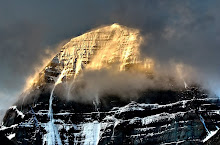Panchacharas
The Panchacharas describe the five modes of conduct to be followed by the believer. The Panchacharas include:[5]
- Lingāchāra - daily worship of the personal Sivalinga
- Sadāchāra - attention to vocation and duty
- Sivāchāra - acknowledging Shiva as the one God and equality among members
- Bhrityāchāra - humility towards all creatures
- Ganāchāra - defense of the community and its tenets
Ashtavarana
The Ashtavaranas, the eightfold armour that shields the devotee from extraneous distraction and worldly attachments. The Ashtavaranas include
- Guru - obedience towards Guru,
- Linga - wearing a linga,
- Jangama - worship of Shiva ascetics as an incarnation of the Lord himself,
- Pādodaka - sipping the water from bathing the Linga,
- Prasāda - sacred offering,
- Vibhuti - smearing holy ash (created using cow dung) on oneself,
- Rudrāksha - wearing a string of rudraksha (holy beads) and
- Mantra - reciting the mantra "Om Namah Shivaya or Om Namah Shivaya Namaha".
Shatsthala
Shatsthala, or the concept of six phases/states/paths, is pivotal to the Lingayat philosophy. Shatsthala is a conflation of Shat and Sthala, which means 'six phases/states/levels' through which a soul advances in its ultimate quest of realisation of the Supreme.
The Shatsthala comprises the
Bhakta Sthala
Maheshwara Sthala
Prasadi Sthala
Pranalingi Sthala
Sharana Sthala
Aikya Sthala
. The Aikya Sthala is the culmination where the soul leaves the physical body and merges with the Supreme.
Lingayat Customs and Practices
Ishtalinga
The Lingayats make it a point to wear the Ishtalinga at all times. The Istalinga is made up of light gray slate stone coated with fine durable thick black paste of cow dung ashes mixed with some suitable oil to withstand wear and tear. Sometime it is made up of ashes mixed with clarified butter. The coating is called Kanti (covering). Though the Ishtalinga is sometimes likened to be a miniature or an image of theSthavaralinga, it is not so. The Ishtalinga, on the contrary, is considered to be Lord Shiva himself and its worship is described asAhangrahopasana.
Thus, for the Lingayats it is an amorphous representation of God. Lingayat thus means the wearer of this Linga as Ishta Linga. Here the wordIshta is a Sanskrit term meaning 'adored' or 'desired'. Unlike Advaitins however, Lingayats do not treat the Ishtalinga as merely a representation of God to aid in realising God but worship the Ishtalinga itself as God. Like most brahmins, Lingayats eat only vegetarian food and should not consume meat of any kind including fish. Drinking of liquor is strictly prohibited.
Lingadharane
Lingadharane is the ceremony of initiation among Lingayats. Though it can be performed at any age, it is usually performed when a child is in its mother's womb 7-8 months old. The family Guru performs pooja and provides istalinga to ythe mother and the mother ties it to her istalinga till the child in born. Once the child is born she puts that istalinga to her child and when he attains the age of 8 -11 years, the child receives Diksha from the family Guru to know the proper procedure to perform pooja of istalinga. By birth, the child wears the Linga at all times for the remainder of his/her life and it is worshipped as their own Istalinga. The Linga is housed in a small silver and wooden box and cloth. It has to be worn on chest as it is believed God resides in our heart. but people wear it on the chest or around the body using a thread.
Unlike other castes of Hinduism like brahmins, which permit only males to participate in the Upanayana or Deeksha ceremonies, Lingayats allow both men and women to participate in these ceremonies in the presence of a satguru. This practice was started by Basavanna himself, who refused to undergo Upanayana, seeing its discrimination against women.
 Special Offerings
Special Offerings
